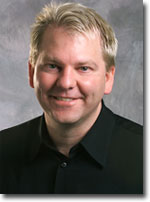Microsoft Big Brains: John Shewchuk

Just before retiring from day-to-day responsibilities at Microsoft, Chairman Bill Gates said that he expected Microsoft's 22 Technical Fellows to get a lot more publicly visible -- now that they wouldn't be living in his shadow. While some of the Microsoft fellows already have been active on the public-speaking circuit, many of them are not widely known outside the company.
I've launched this series -- "Microsoft Big Brains" -- to help remedy that shortcoming. In the coming weeks, I am hoping to profile as many of the company's tech fellows as to whom I can get access.
Microsoft's Technical Fellows came to the company via a variety of different routes. Some of them run divisions inside the company; some focus on particularly thorny technical issues that may span a variety of product units. Regardless of where they sit in the organization, the fellows all have been charged with helping Microsoft craft its next-gen products and strategies, much the way that Gates used his regular "Think Weeks" to prioritize what Microsoft needed to do next.
This Week's 'Big Brain': John Shewchuk Claim to Fame: One of the masterminds behind "Zurich," a key component of Microsoft's Azure cloud infrastructure, and a key playerl in Microsoft's Federated Identity work. How Long You've Been With Microsoft: 15 years (since Microsoft bought his company, Daily Planet Software and morphed it into "Blackbird," the online-content authoring system for MSN) More About You: Currently leads the Connected Systems Division technical strategy and architecture teams for .Net Services and other Azure services components. Was a co-founder of the Windows Communication Foundation (WCF) team and helped build the Common Language Runtime and ASP.Net technologies. Focused on cross-industry interoperability, federated identity and privacy issues. Your Biggest Accomplishment (So Far) at Microsoft: Team(s) You Also Work With: Federated Identity, Workflow, WCF, Azure, SQL Services Why Stay at Microsoft? "There are so few places where you can do things like industry-wide advances in identity or (browser) behaviors."
There are lots of moving parts to Azure, Microsoft's cloud platform. One of the less-flashy but much needed pieces of plumbing is .Net Services, codenamed "Zurich."
.Net Services consists of three components: A workflow service, an identity service and a service bus. The technical fellow in charge of theteam spearheading these services is John Shewchuk.
"We started working on .Net Services about three years ago," Shewchuk reminisced.
He recalled a meeting at that time involving Server and Tools head Bob Muglia, Senior VP of Server Applications Paul Flessner and Connected Systems Division Corporate VP Robert Wahbe.
"I thought we were doing something wrong in Server and Tools," Shewchuk said. "We had all these great (server-side) technologies. Why not host these technologies on behalf of developers? I thought we could do it better than others in the industry."
It turns out the enterprise side of the house wasn't the only part of Microsoft thinking this way. Ray Ozzie, now Chief Software Architect at Microsoft, joined the company in 2005 and had big plans for Microsoft to build hosted consumer wares, like its Live Mesh collaboration/sync service, on top of a shared cloud platform (now known as the Live Framework).
"We didn't know until about a year ago" about the consumer side efforts, Shewchuk said. "We were taking our technologies and hosting them. We brought that effort together with Ray (Ozzie) starting earlier this year."
Shewchuk maintained it wasn't hard to meld the consumer/enterprise strategies and visions. "Both were struggling with things like identity, hosted workflow," and the like, Shewchuk said.
Alongside his partner in crime, Technical Fellow Brad Lovering, Shewchuk worked to make available the key foundational services Microsoft developers have come to expect and rely upon available as services.
"Brad (Lovering) is focused on the declarative technologies. I'm charged with getting it out in the cloud," Shewchuk said. "The ability to describe declaratively what's going on in the cloud... with rules, service bus, workflows," is the goal, he noted. "It's all built on the same underlying foundation."
The .Net Services team was relatively small "but agile," Shewchuk said. During his tenure at Microsoft, he also has led some very large teams, too.
"The projects I tend to work on are usually significant integrations," Shewchuk said. "I get a lot of energy working with other teams -- getting folks to work together, assembling stuff together."
For all of the “Microsoft Big Brains” profiles, check out the Big Brains page.
